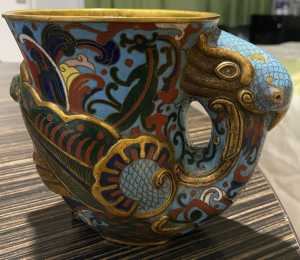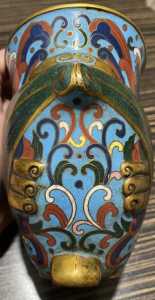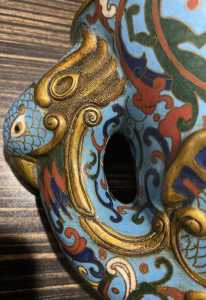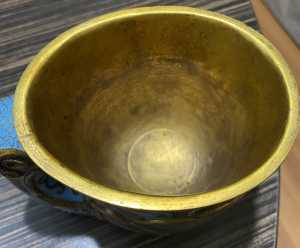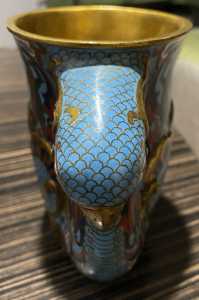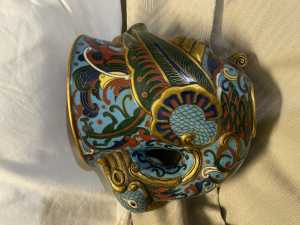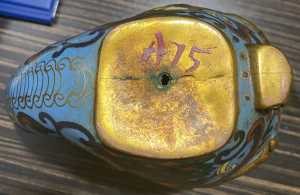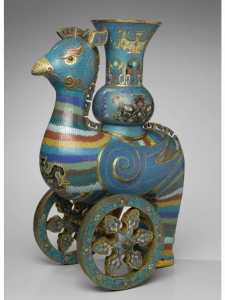The Chinese and Asian Art Forum. For Fans, Collectors and Dealers.
 Basic Rules For the BidAmount Asian Art Forum: Talk about whatever you want. You can even discuss and offer things that are for sale if they are authentic. Maximum image file size per post is 2 MB. Images of 700pxl x 700pxl are optimal if saved at a medium resolution. Be respectful of others and enjoy yourself. Click the YouTube link for a brief tutorial on using the forum. You can also EMBED Videos by cutting and pasting from You-Tube, Vimeo etc.
Basic Rules For the BidAmount Asian Art Forum: Talk about whatever you want. You can even discuss and offer things that are for sale if they are authentic. Maximum image file size per post is 2 MB. Images of 700pxl x 700pxl are optimal if saved at a medium resolution. Be respectful of others and enjoy yourself. Click the YouTube link for a brief tutorial on using the forum. You can also EMBED Videos by cutting and pasting from You-Tube, Vimeo etc.
NOTE: To post an item or add a new post, click open the category title from the FORUM LIST, and CLICK the Blue ADD TOPIC button.
I’m traveling West and I stopped in Santa Fe NM. I went to a consignment store and asked if they had any Asian pieces the nice lady said yes this just came in yesterday. Well it left today. I have never seen anything like this cloisonné but there are several clues. One thing I know it’s not modern. What do you guys think. The lightning in the hotel is horrible.
I can't believe you're making me ask, but can we see the bottom por favor?
Well, a most interesting little beast you've found. I know you've spent a lot more time researching cloisonne than I have, so let me ask you a question. Does Ming cloisonne always have lots of pitting or does it not on some occasions? And if sometimes it does not have pitting, are those only on the finest pieces? If so, then I would say you either have a very nice Ming piece or if not then a very cool and interesting 19th/early 20th example, because it probably lacks the refinement to be high quality earlier-mid Qing.
@johnshoe there are lots of Ming cloisonné with minimal pitting. The clue for me is the wire being used style and details. Was the wire hand forged or was it manufactured. If hand forged it’s period is Ming to early Qing if the wire is manufactured it’s late Qing Early 20th century.
@lotusblack Is the use of pink a clue as to age? I think I remember reading that somewhere, not sure they used pink in very early pieces but wait for someone who remembers exactly, it is interesting. I think I would definitely be asking Peter about it.
@sharonp I do think pink and enamel colors are clues In earlier cloisonné pink was mixed enamels later it was no longer mixed. Pink tends to be darker and brighter in later Qing.
Brian, I am not technical so may I ask how you can tell if wires are hand-made or machine made? Someone mentioned it the other day and I had no idea.
It is in an interesting piece you've found. Is the hole from manufacture or wear? I guess it could have been mounted on something. You didn't say how old you think it is, either.
I don't think it is Ming, I think the yellow is wrong, but I need to look at it on a bigger screen.
@lotusblack The pink as an homogeneous color was avaiable from early qing at least; it came from the west by transfer of technologies "... European glass technology had discovered the chemistry for creating the right type of gold ( comment: or selenium ) compound by the 17th century. The powerful early Qing emperors employed visiting Jesuits from Europe to develop, among other things, the ability for the imperial workshops to produce this gold pink enamel first for porcelain and then cloisonne, especially during the 60-year 18th century reign of Qianlong..." I saw some old pieces with lesser pitting - but no one with NO pitting - it´s in the nature of the recipes of the time. https://www.nytimes.com/2011/02/18/arts/design/18cloisonne.html - this foto was taken from a greater distance ; if you magnify it ( looking glass is enough for that, no kidding ) you´ll see the difference to your piece. Your piece seems to be casted in a more " industrial way " - not lost wax. you´ll see a dividing line on the bottom and can trace it further. In my opinion it is mid to late 19th century; but nicely done.
Thank for the input here is an article to help with the construction.
Bronze vessels were cast not by the lost-wax process (using a wax mold), as formerly supposed, but in sectional molds, quantities of which have been found at Shang sites. In this complex process, which reflects the Chinese early mastery of the ceramic medium, a clay model of the body is built around a solid core representing the vessel’s interior; clay moldingis used to encase the model, then sliced into sections and removed; the model is eliminated; the mold pieces are reconstructed around the core, using metal spacers to separate mold and core; and molten bronze is poured into the hollow space. Legs, handles, and appended sculpture are often cast separately and later integrated in a lock-on pour. Surface decoration may be added to the model surface before the mold is applied, requiring a double transfer from clay to clay to metal, or added in reverse to the mold surface after its removal from the model, with an incised design on the mold yielding a raised design on the metal surface. Ritual vessels range from about 15 cm (6 inches) to more than 130 cm (50 inches) in height with weights up to 875 kg (1,925 pounds). The intricacy and sharpness of the decoration shows that by the end of the 2nd millennium BCE the art of bronze casting in China was the most advanced in the world.
@julia my thought on age is it isn’t of the Ming period the design to me seems extreme and the enamels are to refined. But I don’t believe it’s Early 20th century. Manufacturing process was a little different I will explain the wire more in detail when I can get better pictures. So that leaves a large window in time. One time period stands out for me with being very experimental where items like this were being created Qainlong. Buy I don’t think it was during his reign but later into the next reign so I need to find a comparable for around 1800.
I´m not sure about that beeing generally correct for the era of interest (not 2000 BC ), and if their way of constructing it would give the same appearance as on your piece.
I don't think it is early 20th c either, nor do I think 18th. I was leaning towards late 19th but I still haven't made time for a good look.
@julia If I sell it I will probably list it as late Qing or 19th century without a comparison it would fall in line with that time. If it was made late Qing there has to be another somewhere. I probably won’t keep it because I focus on Japanese cloisonné and the cup stands out to blend into that collection.
Thanks for visiting "The BidAmount Asian Art Forum | Chinese Art"
If you sell on eBay, or have a shop feel free to post images and descriptions and links.
Check back often for discussion about the latest news in the Chinese art and antique world. Also find out about the latest Asian art auctions at Sotheby's, Christie's, Bonhams and Tajans.
Auction results for: fine porcelain, ceramics, bronze, jade, textiles and scholar's objects. As well as Japanese, Thai, Vietnamese and other Asian cultures.
Thank you,
Peter Combs
Topics and categories on The BidAmount Asian Art Forum | Chinese Art
Kangxi vases, Kangxi dishes and chargers, Kangxi ritual pieces, Kangxi scholar's objects, Qianlong famille rose, Qianlong enamels, Qianlong period paintings, Qianlong Emporer's court, Fine porcelain of the Yongzheng period. Chinese imperial art, Ming porcelain including Jiajing, Wanli, Xuande, Chenghua as well as Ming jades and bronzes.
The BidAmount Asian Art Forum | Chinese Art
A free Asian art discussion board and Asian art message board for dealers and collectors of art and antiques from China, Japan, Korea, Thailand, Cambodia, Vietnam and the rest of Asia. Linked to all of the BidAmount Asian art reference areas, with videos from plcombs Asian Art and Bidamount on YouTube. Sign up also for the weekly BidAmount newsletter and catalogs of active eBay listing of Chinese porcelain, bronze, jades, robes, and paintings.
The art of calligraphy - and for the ancient Chinese it certainly was an art - aimed to demonstrate superior control and skill using brush and ink. Calligraphy established itself as one of the major Chinese art forms during the Han dynasty (206 BCE - 220 CE), and for two millennia after, all educated men were expected to be proficient at it.
The Museum’s collections of Asian art span nearly five millennia and encompass the cultures of China, the Himalayas, India, Japan, Korea, and Southeast Asia. In 2007, the Museum launched an initiative to create dedicated galleries for the collection, beginning with a gallery for the arts of Korea ...
Chinese art is full of symbolism, in that artists typically seek to depict some aspect of a totality of which they are intuitively aware.
China Online Museum is the finest online museum of Chinese art. It features Chinese calligraphy, painting, ceramics, bronzes, carving, and other artworks.
Chinese Ceramics & Works of Art. Overview Upcoming auctions Contacts Auction results ... Christie’s sales of Chinese ceramics and works of art showcase centuries of Chinese history. Held throughout the year in London, New York, Paris and Hong Kong, they attract a wide audience of collectors and connoisseurs vying for pieces as diverse as ...
Explore Asian Art Week. Contact the Specialist Department. Chinese Paintings ... Senior Specialist, Head of Sale. [email protected]. Tel:+1 212 641 5760. Bid in-person or online for the upcoming auction:Fine Chinese Paintings on 10 September 2019 at New York. Bid in-person or online for the upcoming auction:Fine Chinese Paintings on 10 ...
Discover an abundance of must-see art from all corners of a vast continent at Christie’s NY Asian Art Week. From contemporary classical and Chinese paintings to works with exemplary provenance from the Art Institute of Chicago, our Rockefeller Paza galleries will be full of ancient treasures and contemporary masterworks in a salute to the vibrant arts of Asia.
Sold to benefit The Art Institute of Chicago’s Asian Art Acquisition Fund, the sale features 84 lots with a focus on Ming and Qing porcelains, and offers a rare insight into the taste for collecting Chinese ceramics and works of art in the Midwest from the end of the 19th century through the 1980s. Highlights include two Wanli wucai garlic-head vases, a Qianlong mark and period, blue and ...
Specialist, Chinese Paintings, Christie's London Dr Malcolm McNeill is a Specialist in Chinese Paintings at Christie’s, based in London. He previously worked as an assistant curator of the Chinese collections and the Victoria and Albert Museum in London, as a researcher at the British Museum, and as a translator and tour guide at the National Palace Museum in Taipei.
The Christie's Education 2020 Conference: The Chinese Art Market 18 Jun 2019 Christie’s Education is delighted to announce our first international academic conference in Asia which will take place in Hong Kong from 26-27 November 2020 at the Hong Kong Convention and Exhibition Centre and will run in parallel with Christie’s Hong Kong Autumn Auctions.
The summer Chinese Art sale in Hong Kong will feature works of art from several private collections, including Qing porcelains and textile from the collection of the legendary Chinese art dealer A. W. Bahr (1877–1959), fine gilt bronze Buddhist sculptures from an old Hong Kong collection, an East Asian collection of Qing dynasty wine cups and jades, and a Japanese collection of Song ceramics ...
Sotheby's Chinese Works of Art Department holds two auctions each year in London, New York, Hong Kong and Paris.
Chinese Art - View Auction details, bid, buy and collect the various artworks at Sothebys Art Auction House.
With more than 340 Chinese works of art dating from the Neolithic to the Republic periods, highlights of this sale include a selection of Qing Imperial monochromes from the collection of Arnold and Blema Steinberg, early ceramics from the Art Institute of Chicago and Chinese porcelain and works of art from the collection of Henry Arnhold.
Results: Sotheby's Asia Week achieved $52.4 million in six strong auctions, exceeding pre-sale estimates. With 76.5% of lots sold and 60.3% of lots surpassing high estimates, the Asian art sales at Sotheby's indicate continued collector interest in the finest works of art from China, India and and the Himalayas.
Today's sale of Important Chinese Art will proceed as planned with sessions at 10 AM and 2 PM EDT. Sotheby's will be monitoring the weather conditions throughout the day and will be available to coordinate alternative bidding options should conditions make it difficult for clients to attend the auction in person.
Bonhams Chinese Art department is renowned for offering the finest works of art representing the richness and breadth of China's artistic heritage, particularly Imperial porcelain, white and spinach green jades, cloisonné and Buddhist art. Specialised international auctions are held globally, including London, Hong Kong and San Francisco.
Bonhams : Chinese Works of Art We use cookies to remember choices you make on functionality and personal features to enhance your experience to our site. By continuing to use our site you consent to the use of cookies. Please refer to our privacy and cookie policies for more information.
Bonhams Fine Art Auctioneers & Valuers: auctioneers of art, pictures, collectables and motor cars. We use cookies to remember choices you make on functionality and personal features to enhance your experience to our site. By continuing to use our site you consent to the use of cookies. ... Chinese Art (US) General enquiries
Bonhams : Fine Chinese Art We use cookies to remember choices you make on functionality and personal features to enhance your experience to our site. By continuing to use our site you consent to the use of cookies. Please refer to our privacy and cookie policies for more information.
Bonhams Fine Art Auctioneers & Valuers: auctioneers of art, pictures, collectables and motor cars Bonhams : Asian Art We use cookies to remember choices you make on functionality and personal features to enhance your experience to our site.
Bonhams are international auctioneers of fine Chinese and Japanese art. We specialise in rare Imperial and Export Chinese ceramics and works of art, as well as Japanese ceramics, fine and decorative works of art from the Neolithic Period to the 20th century. View on map
Bonhams Fine Art Auctioneers & Valuers: auctioneers of art, pictures, collectables and motor cars. We use cookies to remember choices you make on functionality and personal features to enhance your experience to our site. By continuing to use our site you consent to the use of cookies. ... Asian Art Bonhams. Work. 22 Queen St.
